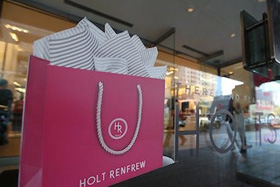How to Retain Customers like a Luxury Brand
 Luxury retailer Holt Renfrew’s flagship Toronto store. Photo: Deborah Baic/The Globe and Mail/CP
Luxury retailer Holt Renfrew’s flagship Toronto store. Photo: Deborah Baic/The Globe and Mail/CP
What keeps consumers coming back? The four key elements that high value brands use to build loyalty.
A number of years ago, I was working on a major project in Australia. It was an 18-month job and it meant I had to travel back and forth from Canada.
Twice a month, I would take my business class seat among my fellow frequent fliers and travel halfway around the world. What made it a good trip and delivered high value to those travellers was different for each of them. Some just wanted to sleep right through the flight,; some wanted a meal; some wanted to skip the meal and just get a blanket and extra pillows after they finished their drink. Each of their individual needs were recognized and attended to. These road warriors had plenty of airlines to choose from that likely offered a similar level of service, but I would often see the same faces. So what kept them coming back?
As part of research my company subsequently conducted on high value services, we found that the decision to fly with a particular airline begins with the perception of a brand’s value. This is influenced by three things. First, the value to price ratio needed to be strong. Second, the traveller had to have some affinity towards the brand, which is about how connected they felt to it and how it made them feel (this is important for triggering loyalty).
Third is the brand’s ability to retain the customer over the long-term. High-value brands manage customer retention well because retention has a direct and significant impact on profitability, as evidenced by the work of Bain & Co.’s Frederick F. Reichheld on the value of customer retention in 1990. Reichheld found that companies can boost profits by almost 100% by retaining just 5% more of their customers, a finding which held true in his later work on retention in web-based service businesses.
It’s tempting to think of this simply as engagement, but for high-value brands it is a matter of re-engagement: offering the customer an experience that is so special that it prompts him or her to actively re-engage repeatedly with the high-value offering. To do this, high-value brands provide their customers with valuable and unique services and benefits.
Most of these services are designed to show a commitment to improving the relationship brands have with the customer by anticipating and responding to perceived needs.
Here are the four components that high-value brands use to build a memorable customer experience.
EXCLUSIVITY
Recognize the individual as someone special for whom a select level of service is available. This is done through product design, availability, and channel access. For example, Holt Renfrew makes personal shopping apartments available to its preferred clients. Fresh flowers and food of the client’s choice are provided and the space can be used for a variety of purposes including ‘wardrobing’, personal styling, trunk shows, and small parties. Only high-value clients are invited to use the apartment.
PERSONALIZATION
This is about matching the level of service to the customer’s expectations but also to their preferences. For example, Harley-Davidson’s customization service allows loyal owners to consult with design specialists to customize their motorcycles to their personal tastes. Knowing your first name is a good start, but working with you to personalize your Harley shows a deep appreciation for your patronage. And it drives greater loyalty.
CONVENIENCE
Travel is fraught with inconveniences so a high-value brand has ample opportunity to improve the experience. Take the Rocky Mountaineer train service in B.C. and Alberta. Its GoldLeaf Service is the most comfortable level of service for its high-value customers. Beyond the great seating, five-star meals, extra amenities and end to end service, the staff manages all the details of your trip, such as arranging to have your luggage brought to your hotel for a seamless, and convenient experience.
FULFILLMENT
This is about opening the door to all possibilities and reaching in to complete the customer experience. Think of the hotel concierge tending to a guest’s needs. In fact, the concierge service American Express offers with its exclusive Centurion card has spawned many tales chronicling the lengths it has gone to fulfill customer needs. One dedicated concierge found a housepainter to paint a Card member’s Paris home, helped select the colour, and made sure the job was done by the specified date.
It should be noted that all of these examples involve the customer spending more money, not expecting something for free. When executed well, serving a high value customer’s needs translates into providing them with something that they will pay extra for.
Customer retention, especially at a luxury brand level, is about confirming the client’s perceived value and their affinity with the brand. But to do this, you have to move beyond responding to demand and anticipating new levels of needs. A brand that is able to identify, address, and reinforce the unique needs of its higher spending customers, is one that will keep them coming back and enhance the profitability of the organization.
Reprinted from ProfitGuide.com 2015




































